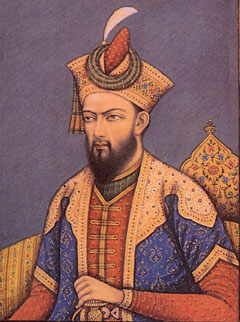 Aurangzeb, also spelled Aurangzib, Arabic Awrangzīb, kingly title ʿĀlamgīr, original name Muḥī al-Dīn Muḥammad (born November 3, 1618, Dhod, Malwa[India]—died March 3, 1707), emperor of India from 1658 to 1707, the last of the great Mughal emperors. Under him the Mughal Empire reached its greatest extent, although his policies helped lead to its dissolution.
Aurangzeb, also spelled Aurangzib, Arabic Awrangzīb, kingly title ʿĀlamgīr, original name Muḥī al-Dīn Muḥammad (born November 3, 1618, Dhod, Malwa[India]—died March 3, 1707), emperor of India from 1658 to 1707, the last of the great Mughal emperors. Under him the Mughal Empire reached its greatest extent, although his policies helped lead to its dissolution.
Early life
Aurangzeb was the third son of the emperor Shah Jahān and Mumtāz Maḥal (for whom the Taj Mahal was built). He grew up as a serious-minded and devout youth, wedded to the Muslim orthodoxy of the day and free from the royal Mughal traits of sensuality and drunkenness. He showed signs of military and administrative ability early; these qualities, combined with a taste for power, brought him into rivalry with his eldest brother, the brilliant and volatile Dārā Shikōh, who was designated by their father as his successor to the throne. From 1636 Aurangzeb held a number of important appointments, in all of which he distinguished himself. He commanded troops against the Uzbeks and the Persians with distinction (1646–47) and, as viceroy of the Deccan provinces in two terms (1636–44, 1654–58), reduced the two Muslim Deccan kingdoms to near-subjection.
When Shah Jahān fell seriously ill in 1657, the tension between the two brothers made a war of succession seem inevitable. By the time of Shah Jahān’s unexpected recovery, matters had gone too far for either son to retreat. In the struggle for power (1657–59), Aurangzeb showed tactical and strategic military skill, great powers of dissimulation, and ruthless determination. Decisively defeating Dārā at Samugarh in May 1658, he confined his father in his own palace at Agra. In consolidating his power, Aurangzeb caused one brother’s death and had two other brothers, a son, and a nephew executed.
Emperor of India
Aurangzeb’s reign falls into two almost equal parts. In the first, which lasted until about 1680, he was a capable Muslim monarch of a mixed Hindu-Muslim empire and as such was generally disliked for his ruthlessness but feared and respected for his vigour and skill. During this period he was much occupied with safeguarding the northwest from Persians and Central Asian Turks and less so with the Marathachief Shivaji, who twice plundered the great port of Surat (1664, 1670). Aurangzeb applied his great-grandfather Akbar’s recipe for conquest: defeat one’s enemies, reconcile them, and place them in imperial service. Thus, Shivaji was defeated, called to Agra for reconciliation (1666), and given an imperial rank. The plan broke down, however; Shivaji fled to the Deccan and died, in 1680, as the ruler of an independent Maratha kingdom.
After about 1680, Aurangzeb’s reign underwent a change of both attitude and policy. The pious ruler of an Islamic state replaced the seasoned statesman of a mixed kingdom; Hindus became subordinates, not colleagues, and the Marathas, like the southern Muslim kingdoms, were marked for annexation rather than containment. The first overt sign of change was the reimposition of the jizya, or poll tax, on non-Muslims in 1679 (a tax that had been abolished by Akbar). This in turn was followed by a Rajputrevolt in 1680–81, supported by Aurangzeb’s third son, Akbar. Hindus still served the empire, but no longer with enthusiasm. The Deccan kingdoms of Bijapur and Golconda were conquered in 1686–87, but the insecurity that followed precipitated a long-incipient economic crisis, which in turn was deepened by warfare with the Marathas. Shivaji’s son Sambhaji was captured and executed in 1689 and his kingdom broken up. The Marathas, however, then adopted guerrilla tactics, spreading all over southern India amid a sympathetic population. The rest of Aurangzeb’s life was spent in laborious and fruitless sieges of forts in the Maratha hill country.
Aurangzeb’s absence in the south prevented him from maintaining his former firm hold on the north. The administration weakened, and the process was hastened by pressure on the land by Mughal grantees who were paid by assignments on the land revenue. Agrarian discontent often took the form of religious movements, as in the case of the Satnamis and the Sikhs in the Punjab. In 1675 Aurangzeb arrested and executed the Sikh Guru (spiritual leader) Tegh Bahadur, who had refused to embrace Islam; the succeeding Guru was in open rebellion for the rest of Aurangzeb’s reign. Other agrarian revolts, such as those of the Jats, were largely secular.
In general, Aurangzeb ruled as a militant orthodox Sunni Muslim; he put through increasingly puritanical ordinances that were vigorously enforced by muḥtasibs, or censors of morals. The Muslim confession of faith, for instance, was removed from all coins lest it be defiled by unbelievers, and courtiers were forbidden to salute in the Hindu fashion. In addition, Hindu idols, temples, and shrines were often destroyed.
Aurangzeb maintained the empire for nearly half a century and in fact extended it in the south as far as Tanjore (now Thanjavur) and Trichinopoly (now Tiruchchirappalli). Behind this imposing facade, however, were serious weaknesses. The Maratha campaign continually drained the imperial resources. The militancy of the Sikhs and the Jats boded ill for the empire in the north. The new Islamic policy alienated Hindu sentiment and undermined Rajput support. The financial pressure on the land strained the whole administrative framework. When Aurangzeb died after a reign of nearly 49 years, he left an empire not yet moribund but confronted with a number of menacing problems. The failure of his son’s successors to cope with them led to the collapse of the empire in the mid-18th century.



